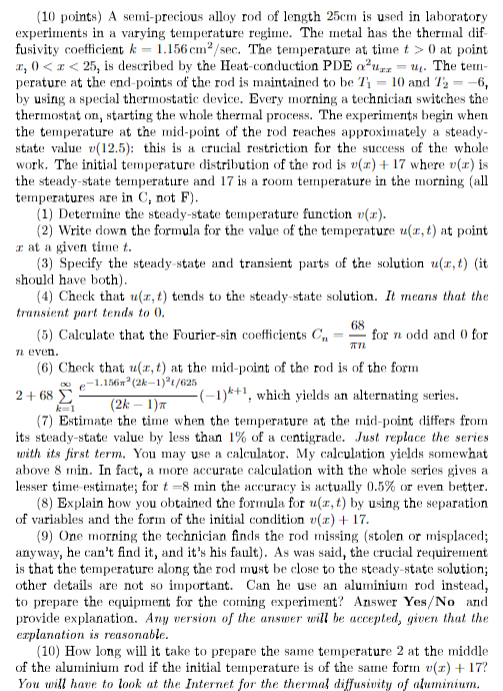Question
Could you guys solve this whole question? This is for the practice question for the final Image transcription text (10 points) A semi-precious alloy

Could you guys solve this whole question?
This is for the practice question for the final
Image transcription text
(10 points) A semi-precious alloy rod of length 25cm is used in laboratory experiments in a varying temperature regime. The metal has the thermal dif- fusivity coefficient k = 1.156em /sec. The temperature at time { > 0 at point 1, 0 < < < 25, is described by the Heat-conduction PDE our - up. The tem- perature at the end-points of the rod is maintained to be 7) = 10 and 73 = -6, by using a special thermostatic device. Every morning a technician switches the thermostat on, starting the whole thermal process. The experiments begin when the temperature at the mid-point of the rod reaches approximately a steady- state value (12.5): this is a crucial restriction for the success of the whole work. The initial temperature distribution of the rod is v(2) + 17 where v(x) is the steady-state temperature and 17 is a room temperature in the morning (all temperatures are in C, not F). (1) Determine the steady-state temperature function v(). (2) Write down the formula for the value of the temperature u(a, t) at point ar at a given time f. (3) Specify the steady-state and transient parts of the solution u(x, t) (it should have both). (4) Check that u(x, () tends to the steady-state solution. It means that the transient part tends to 0. (5) Calculate that the Fourier-sin coefficients C, = - for n odd and 0 for n even. (6) Check that w(a, () at the mid-point of the rod is of the form -1.1567(2k-1)24/625 2+68 5 =1 (2k - 1)* -(-1)*+, which yields an alternating series. (7) Estimate the time when the temperature at the mid-point differs from its steady-state value by less than 1% of a centigrade. Just replace the series with its first term. You may use a calculator. My calculation yields somewhat above 8 min. In fact, a more accurate calculation with the whole series gives a lesser time estimate; for & =8 min the accuracy is actually 0.5% or even better. (8) Explain how you obtained the formula for u(z, () by using the separation of variables and the form of the initial condition v(a) + 17. (9) One morning the technician finds the rod missing (stolen or misplaced; anyway, he can't find it, and it's his fault). As was said, the crucial requirement is that the temperature along the rod must be close to the steady-state solution; other details are not so important. Can he use an aluminium rod instead, to prepare the equipment for the coming experiment? Answer Yes/No and provide explanation. Any version of the answer will be accepted, given that the explanation is reasonable. (10) How long will it take to prepare the same temperature 2 at the middle of the aluminium rod if the initial temperature is of the same form v(x) + 17? You will have to look at the Internet for the thermal diffusivity of aluminium.
(10 points) A semi-precious alloy rod of length 25cm is used in laboratory experiments in a varying temperature regime. The metal has the thermal dif fusivity coefficient k = 1.156 cm/sec. The temperature at time t> 0 at point r, 0
Step by Step Solution
There are 3 Steps involved in it
Step: 1

Get Instant Access to Expert-Tailored Solutions
See step-by-step solutions with expert insights and AI powered tools for academic success
Step: 2

Step: 3

Ace Your Homework with AI
Get the answers you need in no time with our AI-driven, step-by-step assistance
Get Started


